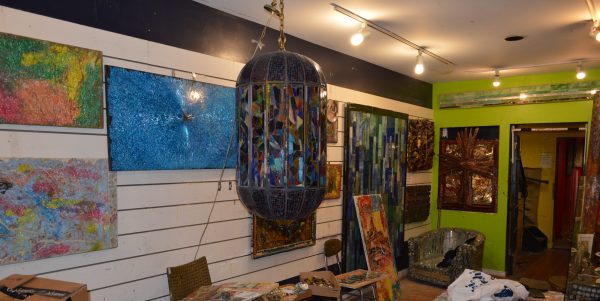Christian artist creates Ner Tamid for Jewish congregation
In Jewish tradition, the first day of Tishri (the seventh month on the lunar calendar) is set apart as Rosh Hashana – a day of rest commemorating the anniversary of God’s act of creation. Loring Cornish, a Baltimore-based artist and faithful follower of Jesus Christ, grew up in a church where he often heard the creation story. But Cornish knew almost nothing about Judaism when he was asked if he could design a congregational centerpiece – a Ner Tamid – for a local synagogue. Cornish was immediately intrigued, and what began as an artistic spark to fashion a sacramental object quickly fueled his Christian spirit with a desire to embrace its Jewish roots.
“Jill (Yesko) approached me about 2 years ago,” explained Cornish, while relaxing at his studio in Fells Point. “She said her congregation (Kol HaLev Synagogue in Baltimore) wanted a beautiful light for their synagogue. I told Jill I had a great idea, so I started creating these huge pieces. When Jill reached out again this summer, I showed her a six-sided piece.
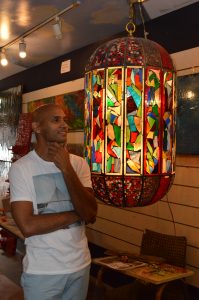
“To me, the six sides represent the six points on the Star of David. The multiple colors and angular cuts of the glass represent the fullness of life. Life is full of color but comes at you from so many angles. Like a flame. That’s what the Ner Tamid means to me.”
The Ner Tamid (or Eternal Light) is a luminous synagogue fixture which may be found hanging above the ark (or cabinet) which contains the Torah scroll. While, “often associated with the menorah…” (Exodus 25:31-40), the Jewish Virtual Library also notes that, “our sages interpreted the Ner Tamid as a symbol of God’s eternal and imminent Presence in our communities and in our lives.”
Seizing on the idea of an “imminent Presence”, Cornish poured his talent into the task at hand. Much to his delight, he found that people “loved ” his beautiful creations.
“Regardless of your religious beliefs or non-belief – personally, I am a Christian – every one of us has a light burning in our souls. A passion for living, which I call an internal flame. My Christian belief would say the light in our souls is Jesus, but across the board, I believe that light is the light of hope. It’s something which burns within you constantly. Whether it is hope for a single congregation, the entire world, or the individual who is struggling with a problem and doesn’t know if she can make it to the next day. It’s the kind of light which – even if it goes out – can be rekindled.
“I’ve had instances in my own life where I’ve wondered how I would ever go on, and if I even wanted to go on. But there was that light. So to me, the Ner Tamid is a visible representation of that second chance. A visible representation of an eternal truth. Again, that’s across the board, for people of all world-views.”
Rabbi Geoff Basik – the spiritual leader of Kol HaLev Synagogue – told the Baltimore Post-Examiner that obtaining a Ner Tamid at this point in time presents a manifold blessing, not only for what it means to the congregation but for the greater community as a whole.
“This congregation is 10 years old, and each year represents a different developmental leap. We have landed here, at Brown Memorial Woodbrook Presbyterian Church and signed a five-year lease. We are growing – we have over 100 families now – and I feel the need for a real, established presence.
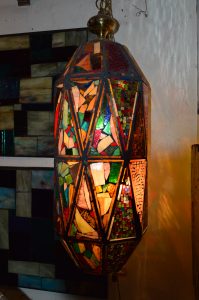
“For us, the Ner Tamid is not a sign but rather a symbol of an established presence. I didn’t know Loring was a man of faith – he has a very deep Christian belief – but as a man of faith, he took this idea of an established presence to heart. I think he did an amazing job. He created larger Ner Tamids that are just impractical for smaller spaces, but they are gorgeous. They took my breath away.
“Normally, a piece of this stunning quality is prohibitively expensive. But Jane Guyer, the wife of our president Dr. Bernard Guyer, asked me what she might donate in honor of her husband. I immediately said a Ner Tamid. It’s a very lasting tribute to the lay leader who has helped us in our organization. Coming as this has at this point in my rabbinate, and at the ten-year mark of our congregation, I don’t know what could top this. I am totally satisfied.”
Cornish’s exquisite creation presently rests on top of the mobile Torah ark. Basik said he is hoping a permanent installation will happen in the small chapel the two congregations share.
“Jewish communities need a few things. They need a cemetery, they need a school; a learning place and a prayer place. But there are a few material needs, too. We need a shofar, for example. We need Shabbat candles. Prayer shawls, a Torah, but we really need the Ner Tamid.
“There is a Proverb which says, ‘The human spirit is the light of G-d.’ meaning that within us, we all have this spark of eternality. Loring ran with this idea, that – despite the trials and tribulations of life – there is a core flame that burns. No matter how dark the world might seem we have to maintain a little bit of hope. We are, in my opinion, kind of obligated to tend that flame so it lights up our lives and lights up the lives of the world.”
So, the sacramental underlines the sacred?
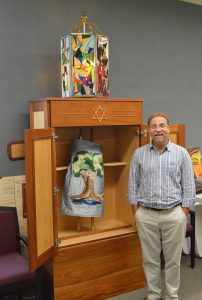
“Yes,” explained Basik. “There is a relationship between the experience and the knowledge. The reason we named this synagogue community Kol HaLev – Voice of the Heart – is because, in the ancient world, the heart was the seat of both cognitive wisdom and intuitive knowledge. We want to be very integrative here: Head, heart, hands. Thinking, feeling, doing. Believing, belonging, behaving. That’s our shorthand way of explaining what we’re doing.”
Believing and belonging might also be a good way to describe both Cornish’s walk of faith and his immersion into the Jewish community.
“A few years ago, I was honored to have a show at the Jewish Museum of Maryland”, said Cornish. “It was called, ‘In Each Other’s Shoes’. In my earliest beginnings as an artist, I was all gung-ho about doing Jewish pieces. Then a friend asked, ‘But Loring – what do you know about the Jewish struggles?’ When she said this, it hit me deeply because I realized I was on the outside looking in. Aside from hearing Bible stories in church about the Israelites and seeing the occasional film about The Holocaust, I didn’t have any sort of Jewish background. I really didn’t know what I thought I knew. I felt very small and thought, ‘How can I make art about you if I know nothing about your life?’
“So I began reading and learning.
“Reading Elie Wiesel’s book, Night, filled me with tangible evidence to produce tangible pieces based on the Holocaust. It was as if something had taken the top of my head off and just filled me with knowledge. Since then, I’ve been able to produce art about both the Black and the Jewish struggle. Being asked to be the first Black artist to do a solo show at the Jewish Museum was huge. And then Jill walked into my studio. That’s why I am so honored that a Jewish congregation would approach me – a Christian – and ask me to create something which will be a focal point of their worship experience.”
A quick tour of his burgeoning studio reinforced Cornish’s heartfelt backstory. The walk-through also revealed a love for the Torah which seemingly went well beyond the Ner Tamid commission. We asked if this ongoing communal relationship has in any way also strengthened his Christian faith?
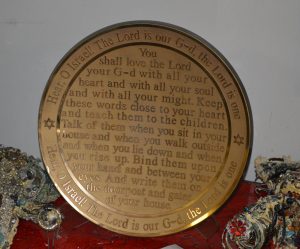
“What it has done is not only make me appreciate Jewish tradition, but it has also made me see how selfish one can be in their own beliefs. We tend to say, ‘I believe this and you shouldn’t believe that’. I’ve grown to understand that we’re all here, and we have choice. My choice doesn’t make me completely right, and your choice doesn’t make you completely wrong.”
Basik said he also sees a spiritual advantage in taking a more universalistic approach.
“Pastor Randy Clayton (of Brown Memorial) and I have something to say to the world at large: That religion is not monopolized and exclusive. We’re all in this together. While the differences are significant – the commonalities are what is important. That’s a pretty good message. It would be great if we could rent to a small Muslim community at some point, and then have all of the Abrahamic messages here. Kol HaLev is keen on this idea. We’re not a circle-the-wagons congregation. We prize our traditions but think everyone can gain from our message.”
The rabbi concluded, “It’s our hope that the church will allow us to hang the Ner Tamid in the chapel. If not, we’ll just use it sitting on top of the ark. Our congregation will be fine with that.”
And perhaps excited as well – knowing this Rosh Hashana will be something special at Kol HaLev.
“There’s a kind of authenticity and a legitimacy that you can’t help but feel now because you’re in the presence of a Ner Tamid.”
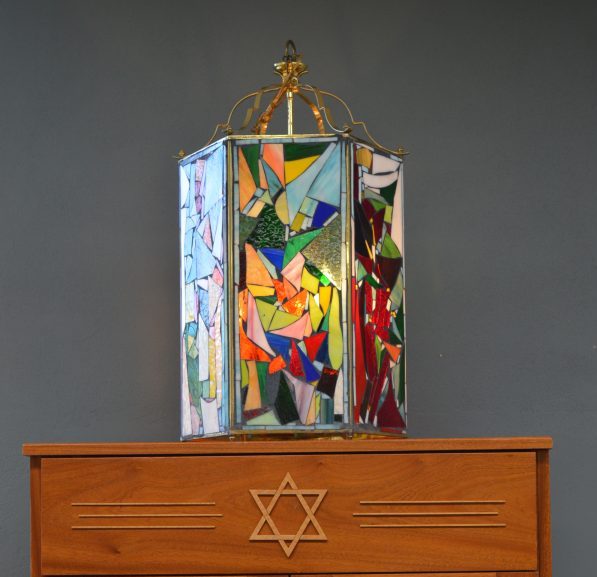
Editor’s note: This is the thirteenth part of an ongoing series which will look at the places and people that make up the rich history and diverse nature of spirituality, belief, and observance in Baltimore and beyond. Read the series here.

Anthony C. Hayes is an actor, author, raconteur, rapscallion and bon vivant. A one-time newsboy for the Evening Sun and professional presence at the Washington Herald, Tony’s poetry, photography, humor, and prose have also been featured in Smile, Hon, You’re in Baltimore!, Destination Maryland, Magic Octopus Magazine, Los Angeles Post-Examiner, Voice of Baltimore, SmartCEO, Alvarez Fiction, and Tales of Blood and Roses. If you notice that his work has been purloined, please let him know. As the Good Book says, “Thou shalt not steal.”

